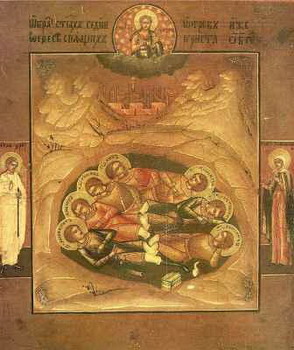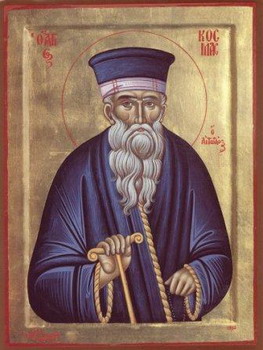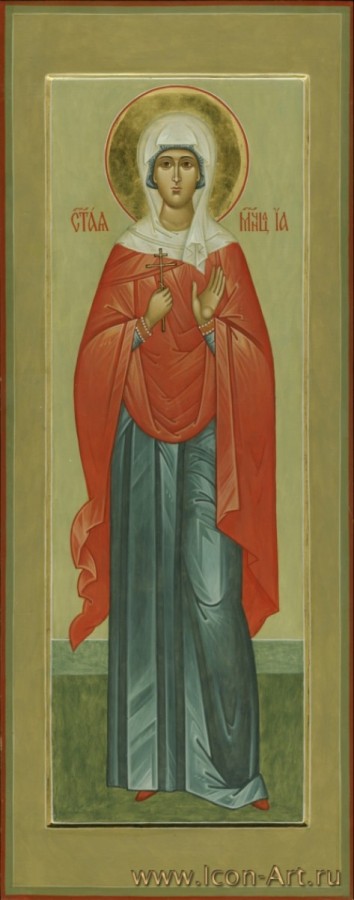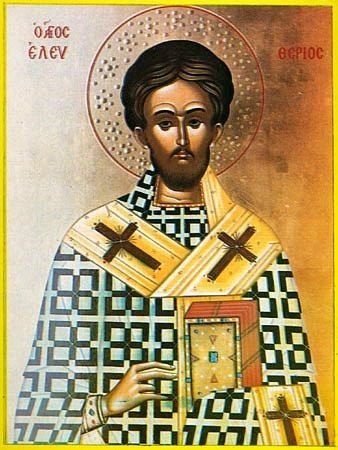|
|
The Seven Holy Youths of Ephesus There was a great persecution of Christians tinder the Emperor Decius. The Emperor himself went to Ephesus, and there prepared a riotous festival in honour of dead idols and also a vicious slaughter of Christians. Seven youths, all of them soldiers, held themselves apart from the foul offering of sacrifice, and wholeheartedly begged the one God to save the Christian people. They were the sons of the most eminent administrator in Ephesus, and their names were: Maximilian, Iamblichus, Martinian, John, Dionysius, Exacustodianus and Antoninus. When they were accused before the Emperor, they hid on a hill called Ochlon outside Ephesus, concealing themselves in a cave. When the Emperor discovered this, he commanded that the cave be walled-in. God then, in His far-seeing providence, let a miraculous and long-lasting sleep fall on the young men. The imperial courtiers Theodore and Rufinus, secret Christians, caused a copper catafalque with leaden plaques to be made, on which were written the names of these young men and their death by martyrdom under the Emperor Decius. More than two hundred years then passed. In the time of the Emperor Theodosius the Younger (408-450), there arose a great dispute about the resurrection of the dead, for there were some who doubted the resurrection. Emperor Theodosius was greatly grieved at this dispute among the faithful, and prayed God that He would in some way reveal the truth to the people. At that time of altercation in the Church, some shepherds of a certain Adolius, who owned Ochlon, began building pens for their sheep and took stone after stone from this cave. Then the youths awoke from their sleep, young and in full health as they had fallen asleep. This marvel was noised abroad on all sides, and Theodosius himself came with a great retinue and spoke apart with the young men. After a week, they again entered into sleep, the sleep of death, to await the General Resurrection. The Emperor wanted to place their bodies in golden coffins, but they appeared to him in a dream and told him to leave them in the earth, as they had been. There was a great persecution of Christians tinder the Emperor Decius. The Emperor himself went to Ephesus, and there prepared a riotous festival in honour of dead idols and also a vicious slaughter of Christians. Seven youths, all of them soldiers, held themselves apart from the foul offering of sacrifice, and wholeheartedly begged the one God to save the Christian people. They were the sons of the most eminent administrator in Ephesus, and their names were: Maximilian, Iamblichus, Martinian, John, Dionysius, Exacustodianus and Antoninus. When they were accused before the Emperor, they hid on a hill called Ochlon outside Ephesus, concealing themselves in a cave. When the Emperor discovered this, he commanded that the cave be walled-in. God then, in His far-seeing providence, let a miraculous and long-lasting sleep fall on the young men. The imperial courtiers Theodore and Rufinus, secret Christians, caused a copper catafalque with leaden plaques to be made, on which were written the names of these young men and their death by martyrdom under the Emperor Decius. More than two hundred years then passed. In the time of the Emperor Theodosius the Younger (408-450), there arose a great dispute about the resurrection of the dead, for there were some who doubted the resurrection. Emperor Theodosius was greatly grieved at this dispute among the faithful, and prayed God that He would in some way reveal the truth to the people. At that time of altercation in the Church, some shepherds of a certain Adolius, who owned Ochlon, began building pens for their sheep and took stone after stone from this cave. Then the youths awoke from their sleep, young and in full health as they had fallen asleep. This marvel was noised abroad on all sides, and Theodosius himself came with a great retinue and spoke apart with the young men. After a week, they again entered into sleep, the sleep of death, to await the General Resurrection. The Emperor wanted to place their bodies in golden coffins, but they appeared to him in a dream and told him to leave them in the earth, as they had been.The Hieromartyr Cosmas, Equal to the Apostles Born in Aitolia, in the village of Megadendron (Great Tree), he went off to the Holy Mountain as a young man and there, in the monastery of Philotheou, was tonsured as a monk. But, urged by a constant desire to preach the Gospel to the people, he went to Constantinople, where he asked the blessing of Patriarch Seraphim 11 for this. He visited all the Danube area, preaching the Gospel, working especially in Albania, where he suffered at the hands of a certain Kurt Pasha, who was stirred up by the Jews against Cosmas. Cosmas was strangled by the Turks and then cast into a river, in 1779. His wonderworking relics are preserved in the village of Kalikontasi, in the church of the holy Mother of God, not far from the town of Berati. He suffered for his Lord at the age of sixty-five. Born in Aitolia, in the village of Megadendron (Great Tree), he went off to the Holy Mountain as a young man and there, in the monastery of Philotheou, was tonsured as a monk. But, urged by a constant desire to preach the Gospel to the people, he went to Constantinople, where he asked the blessing of Patriarch Seraphim 11 for this. He visited all the Danube area, preaching the Gospel, working especially in Albania, where he suffered at the hands of a certain Kurt Pasha, who was stirred up by the Jews against Cosmas. Cosmas was strangled by the Turks and then cast into a river, in 1779. His wonderworking relics are preserved in the village of Kalikontasi, in the church of the holy Mother of God, not far from the town of Berati. He suffered for his Lord at the age of sixty-five.Martyr Thathuil
Martyr Eudocia of Persia (362) The Holy Nun-Martyress Eudokia was an illustrious Roman, living in the IV Century. The army of the Persian emperor Sapor took her into captivity amidst 9,000 Christians. Being in captivity, the saint preached among the Persian women and converted many of them to Christianity. For this she was subjected to lengthy and fierce tortures and then beheaded (+ c. 362-264). The Holy Nun-Martyress Eudokia was an illustrious Roman, living in the IV Century. The army of the Persian emperor Sapor took her into captivity amidst 9,000 Christians. Being in captivity, the saint preached among the Persian women and converted many of them to Christianity. For this she was subjected to lengthy and fierce tortures and then beheaded (+ c. 362-264).Martyr Eleutherius of Constantinople (4th c.) The Holy Martyr Eleutherius served as the cubicularius (bed-chamberlain) at the court of the emperor Maximian Hercules (284-305). When he accepted Christianity, he then settled on a country estate, and built a church at his home. One of the servants reported to the emperor, that Eleutherius had become a Christian. The emperor ordered the saint to offer pagan sacrifice. The saint refused and for this he was beheaded. The relics of Saint Eleutherius were situated at Constantinople, and afterwards transferred to Italy, in the city of Theato. The Holy Martyr Eleutherius served as the cubicularius (bed-chamberlain) at the court of the emperor Maximian Hercules (284-305). When he accepted Christianity, he then settled on a country estate, and built a church at his home. One of the servants reported to the emperor, that Eleutherius had become a Christian. The emperor ordered the saint to offer pagan sacrifice. The saint refused and for this he was beheaded. The relics of Saint Eleutherius were situated at Constantinople, and afterwards transferred to Italy, in the city of Theato.New Martyr Chrestos of Preveza (1668)
|